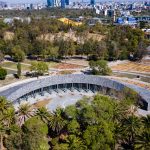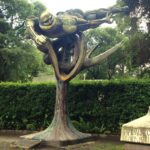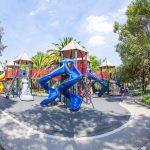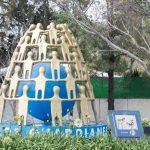
The Museum of Natural History (Museo de Historia Natural MHN) is a complex of ten hemispherical structures and a total exhibition area of some 7,500 square meters. The collection includes some 2,775 specimens distributed amongst six broad sections:
The Museum foyer and green areas allow for additional environmental education and scientific activities.
The Diplodocus carnegii, a gift from the steel magnate’s wife, previously occupied the El Chopo Museum where it provided a centerpiece for that museum from 1931 until 1963. It was at last moved to it’s present location in 1964.
In 1999 the museum was transferred to administration by the Mexico City Secretariat of the Environment. The institutions history is almost as storied as that of the Diploducus.
1822 – Agustín de Iturbide creates the Mexican National Museum based on the Natural History Cabinet and the Antiquities Conservatory.
1866 – Maximiliano of Habsburg created a Public Museum of Natural History, Archaeology, and History
1870 – The Benito Juárez administration recreates a Mexican National Museum.
Porfiriato – The same National Museum grows to such an extent that it’s divided into History, Archaeology, and National History areas.
1909 – The National Museum of Archeology, History, and Ethnography and a National Museum of Natural History are opened within the Palacio de Cristal, today the Museo del Chopo.
1929 – The two national museums are taken over the National Autonomous University of Mexico, but quickly went into decline and were temporarily closed. While some of the collection was moved to the UNAM Museum of Geology across Santa Maria la Ribera, it remained something like “the Mexico City museum” for close to 30 years.
1964 – the National Museum of Natural History is inaugurated
1999 – Construction begins on the Chapultepec facility
2022 – The Chapultepec Center for Environmental Culture opens as an independent cultural center outside the museum. This was part of a major initiative to restore the park’s diversity, and to educate the public on protecting this and many of Mexico City’s natural resources and ecosystems.
In 2022, with the opening of the Environmental Culture Center, the Museum of Natural History refocused its mission on protecting and researching the many thousands of speciments in its collection. The National Insect Collection, for example, consists of some 55,000 species, and can be visited by appointment.
The Museum of Natural History (Museo de Historia Natural MHN) is a complex of ten hemispherical structures and a total exhibition area of some 7,500 square meters. The collection includes some 2,775 specimens distributed amongst six broad sections:
The Museum foyer and green areas allow for additional environmental education and scientific activities.
The Diplodocus carnegii, a gift from the steel magnate’s wife, previously occupied the El Chopo Museum where it provided a centerpiece for that museum from 1931 until 1963. It was at last moved to it’s present location in 1964.
In 1999 the museum was transferred to administration by the Mexico City Secretariat of the Environment. The institutions history is almost as storied as that of the Diploducus.
1822 – Agustín de Iturbide creates the Mexican National Museum based on the Natural History Cabinet and the Antiquities Conservatory.
1866 – Maximiliano of Habsburg created a Public Museum of Natural History, Archaeology, and History
1870 – The Benito Juárez administration recreates a Mexican National Museum.
Porfiriato – The same National Museum grows to such an extent that it’s divided into History, Archaeology, and National History areas.
1909 – The National Museum of Archeology, History, and Ethnography and a National Museum of Natural History are opened within the Palacio de Cristal, today the Museo del Chopo.
1929 – The two national museums are taken over the National Autonomous University of Mexico, but quickly went into decline and were temporarily closed. While some of the collection was moved to the UNAM Museum of Geology across Santa Maria la Ribera, it remained something like “the Mexico City museum” for close to 30 years.
1964 – the National Museum of Natural History is inaugurated
1999 – Construction begins on the Chapultepec facility
2022 – The Chapultepec Center for Environmental Culture opens as an independent cultural center outside the museum. This was part of a major initiative to restore the park’s diversity, and to educate the public on protecting this and many of Mexico City’s natural resources and ecosystems.
In 2022, with the opening of the Environmental Culture Center, the Museum of Natural History refocused its mission on protecting and researching the many thousands of speciments in its collection. The National Insect Collection, for example, consists of some 55,000 species, and can be visited by appointment.
 difusionmhn.sma@gmail.com
difusionmhn.sma@gmail.com
 +52 (55) 5515 0739
+52 (55) 5515 0739
 http://data.sedema.cdmx.gob.mx/museodehistorianatural/
http://data.sedema.cdmx.gob.mx/museodehistorianatural/

Nearest at 0.44 kms.

Nearest at 0.47 kms.

Nearest at 0.51 kms.

A final resting place for some of Mexico's most important people . . .

A giant kids play area just across the Calzada Flotante in Chapultepec . . .

A mysterious fountain placing responsibility for the future on children . . .

A new amusement park and entertainment center in the heart of Chapultepec . . .

An often-overlooked and meticulous fountain and gardens in Chapultepec . . .